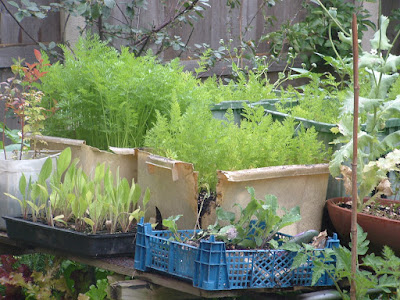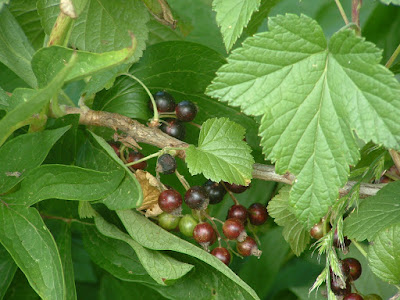Roots
I harvest all the garlic bulbs at the beginning of June and once that spot was cleared I resowed it with beet seed, some of which have sprouted (still pretty small). I also resowed other bare spots with more beet seed, and most of it seems to have come up.
Earlier sown beets are growing--one or two getting big--most small. Some onions forming little bulbs now. Celery looking lush and leafy.
No sign of parsnips, so I hoed away the weeds in its patch and relegated it to the brassica section (right next to it) for replanting with young kale and spring broccoli.
Earliest sown carrots in planters are at about finger size now--probably as big as they'll get, given the size of the planters.
Shallots in Roots bed all have big flower heads on them. None harvested yet.
Peas and beans
I harvested all the broad beans over the month of June, and cleared them away at the end of the month. Their patch, and the adjoining failed parsnip patch, has been replanted with young kale and spring broccoli.
First batch of early peas was harvested and cleared away: resown with rutabaga seed. Lots of mange tout peas harvested in June, but not cleared away. Maincrop peas and second batch of earlies still growing but formed plenty of pods.
Nearly all dwarf French beans up and growing, but no flowers yet. Only about nine runner bean plants survived the slugs (40 seeds sown). Growing quickly but no flowers yet.
Brassicas
As mentioned above, kale and spring broccoli planted out. Rutabaga seeds sown but no plants appeared yet. A few earlier sown rutabaga growing.
Two cauliflowers harvested in June, one small one big (both given away). Two plants left, one of which has a nice head growing; the other plant is spindly and has no head.
Been thinning and eating summer cabbages as greens--none forming heads yet. Two very large Savoy cabbages (leftover from last winter) are forming heads--the outer leaves of one of them stretch about three feet across (!!).
Brussels sprouts and broccoli growing nicely in the holding bed. New winter cabbages growing well in seed tray, soon to be planted out (probably after the peas are cleared away).
Miscellaneous
Planted out all the tender plants started indoors: tomatoes, sweet corn, tomatillos, zuccini, squash, pumpkin, cucumber and melon (some of these in the ground, others in containers). Tomatoes, cucumber and tomatillos started flowering in June. Others are still thinking about whether or not to start growing! One zuccini plant looks promising, at least...
Sowed a row of radish seeds in between the squash plants.
Leeks growing slowly. Lots of chard growing, lots eaten already. Most of the chard was self-sown and moved to the appropriate bed: I've been pulling out (and eating) the plants which are trying to bolt.
Lettuces in pots on the patio table are growing well--slugs haven't found them. Been eating salads about once a week in June. Shallots in Misc bed are beginning to flower.
Potatoes
Potato plants all about waist high now, and covered in pretty white and pink flowers. I've staked them up where they're draping over adjacent beds. A few volunteer potatoes (from the Misc bed) were dug up and eaten in June.
Fruit
All morello cherries harvested in June, which is a month earlier than normal. Fruit was small and sparse and tree looks a bit stressed (it was moved over winter and has endured a hot and dry spring).
Nearly all redcurrants harvested in June. Enough for eating out of hand, or adding to smoothies. Began picking blackcurrants--many more than redcurrants, but still just for eating/smoothie-ing.
Almost all maincrop strawberries harvested (around a dozen), alpine strawberries started, and sweet Kordia cherry harvest started (only a few dozen of these on the tree) in June. Picked two gooseberries to test (not ready yet).
Plums, apples, raspberries, figs, blueberries and almonds all still growing.
Perennials and herbs
The new artichoke plants are still growing strongly, at about waist height. No flowers on them, but I hope to pick some next year.
Rhubarb both look dead. Hopefully they're not...
Asparagus from seed growing a bit bigger but still very small and spindly.
Sorrel flowering.
A bit more die-back on the rosemary. Thyme, tarragon and chives have plenty of growth. Bergamot, (new) chamomile and mint still growing. Chervil (in pots) finished. Dill in pot going to seed. Summer savory in pot growing nicely. Sowed more dill and basil in pots, and parsely in the ground: none sprouted yet.










